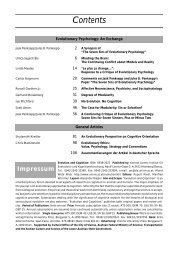Contents - Konrad Lorenz Institute
Contents - Konrad Lorenz Institute
Contents - Konrad Lorenz Institute
You also want an ePaper? Increase the reach of your titles
YUMPU automatically turns print PDFs into web optimized ePapers that Google loves.
Gestalt Experiments and Inductive Observations<br />
p45). In addition, Gestalt perception deals with the<br />
whole (1948, p139; 1959, p306; 1981, p46). It is able<br />
to get an overview of a multitude of aspects of a system<br />
and can extract a lawful relationship out of it<br />
(1948, p64). For this reason, effective use of Gestalt<br />
perception can be made if all behavioral patterns of<br />
organisms are observed in their natural context. As<br />
a perceptual mechanism Gestalt perception has<br />
qualitative information as input. This justifies the<br />
qualitative approach to observation (1948, p64). Finally,<br />
Gestalt perception does not need a hypothesis<br />
(1948, p63). It works best when the researcher is relaxed<br />
and contemplates his object of study while<br />
unconsciously collecting data (1959, p316; 1981,<br />
pp45f). In fact, rational reasoning about details of<br />
the object negatively influenced the operation of<br />
Gestalt perception (1959, pp314, 317). In this case,<br />
the features of Gestalt perception show that observation<br />
has to be conducted without rational influences<br />
based on theories or hypothesis. To sum up,<br />
LORENZ tries to make clear that the distinctive aspects<br />
of the ethological observational approach is<br />
chosen in accordance with a cognitive enterprise<br />
that relies on Gestalt perception. Observations yield<br />
effectively knowledge because this powerful ratiomorphic<br />
mechanism is employed. The idea that Gestalt<br />
perception is predominantly used for ethological<br />
observations (as well as for systematics) can be<br />
found throughout LORENZ’s writings (1948, pp61f,<br />
213ff; 1954, pp197ff; 1958, pp251ff, 278; 1959,<br />
pp306ff, 311, 315; 1963a, pp8f; 1981, pp40ff).<br />
Conclusion<br />
A<br />
A<br />
A<br />
Entirety<br />
B<br />
B<br />
B<br />
Gestalt<br />
Perception<br />
Ethological<br />
Approach to<br />
Observation<br />
Induction<br />
Experiment<br />
The necessity of B is conceptually contained in A;<br />
accepting A means also doing B<br />
B fulfills ideally the demands of A<br />
The cognitive mechanism A is a powerful tool for<br />
obtaining knowledge from the biological method B<br />
Figure 1: Overview of LORENZ’s justificatory system.<br />
I have argued that on LORENZ’s view the observation–experiment<br />
relation is largely analogous to the<br />
Gestalt perception–induction relation. Experiment<br />
needs foregoing observation so that it can be conducted<br />
meaningfully. Similarly, induction needs<br />
Gestalt perception that leads induction the way. Observation<br />
and Gestalt perception discover new principles,<br />
whereas experiment and induction have to<br />
give an analytic confirmation. Gestalt perception is<br />
the crucial cognitive tool for ethological observation,<br />
while rational induction is important for experimental<br />
analysis and confirmation. LORENZ<br />
makes clear that the relation between Gestalt perception<br />
and induction is very complex. However, he<br />
does not give a concrete account of the interplay between<br />
these two cognitive mechanisms and their relation<br />
to the biological approach. For this reason,<br />
while the Gestalt perception–induction relation can<br />
be largely mapped onto the observation–experiment<br />
relation, it is not clear in detail what the actual<br />
role of rational processes in observation is and to<br />
which extent Gestalt perception is also important<br />
for ethological experiments.<br />
The result of my reconstruction of LORENZ’s justificatory<br />
relationships between the ideas of entirety,<br />
Gestalt perception, induction, observation and experiment<br />
are illustrated in Figure 1. 7 LORENZ’s work<br />
exhibits a justificatory system in which all of his relevant<br />
ideas are logically related. What becomes<br />
clear is the fact that the ideas about entirety/systemic<br />
entity (Ganzheit) and the claims about induction<br />
and inductive science function as primitive<br />
principles. They are not justified by other items, but<br />
both are used to justify the need for Gestalt perception<br />
as a cognitive tool and the necessity of observations<br />
in an ethological manner. Furthermore, three<br />
different items lend support to the use of Gestalt<br />
perception as a cognitive tool: the views about entirety,<br />
induction, and experiments. It is not very surprising<br />
that Gestalt perception is justified from different<br />
perspectives. While this cognitive<br />
mechanism is very important for LORENZ’s epistemology,<br />
it is hardly endorsed by other post-war biologists.<br />
On LORENZ’s account Gestalt perception has<br />
very strong capacities, e.g., finding scientific hypotheses.<br />
LORENZ needs to justify the use and need<br />
of this non-rational (albeit ratiomorphic) process<br />
that he uses to stress as a tool for scientific inquiry.<br />
Finally, my analysis shows that the primary aim<br />
of LORENZ’s justificatory efforts is the ethological approach<br />
to observation. Even though LORENZ associates<br />
Gestalt perception with observation, it is not<br />
the case that the specific features about the observational<br />
approach are used to justify the use of Gestalt<br />
perception. Rather, the ideas about Gestalt perception<br />
justify the way observations were carried out by<br />
Evolution and Cognition ❘ 167 ❘ 2003, Vol. 9, No. 2








